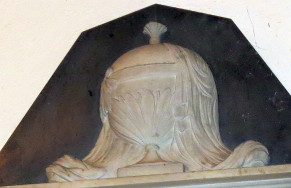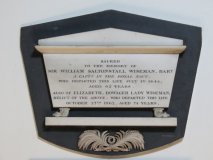Burgiss of Uxbridge: a dynasty of Stonemasons
Typical carved pot in high relief, by John Burgiss of Uxbridge.
The stonemasons Burgiss of Uxbridge made monumental tablets for several churches in west Middlesex, in the vicinity of Uxbridge and Hillingdon more generally, and a little further afield in Buckinghamshire. The dynasty started with two called John Burgiss, father and son, the elder dying in 1820, the younger with dates 1770/1-1830. Two sons of the younger John Burgiss also became stonemasons, William Norwood Burgiss (b. c.1796), who settled in Denham, and Edward Burgiss of Uxbridge, b.1801. The next generation included Frederick Charles Burgiss (b.1829), stonemason also of Uxbridge. The spelling of the surname was not entirely consistent, with Burgis and Burgess also appearing in records, and perhaps another branch of the same family, were the Burgis family of Northamptonshire, active in the 19th Century, with one daughter of the family marrying the stonemason James Tyler and moving to the United States by the early 20th Century. There was a well known family of painters called Burgess, most notably the Royal Academician John Bagnold Burgess, but there is no obvious link to the Burgiss family of stonemasons in Uxbridge.
John Burgiss was associated with the famous architect John Soane at one point, being employed by him on stonework for the Uxbridge Treaty House in 1802. However, 10 years later John Burgiss (Jr) was listed as a bankrupt. The firm was flourishing again by the 1820s, and in the 1830s employed at least one assistant. The firmís output continued through the 1840s, but in 1853, E. Burgiss was also bankrupt. The fact that the younger generation continued as stonemasons suggests a revival of the firm at a later date, though I have not come across any monuments from after 1850.
The tablets of John Burgiss date from about 1800-1829, the year before the younger J. Burgiss died, and we cannot tell whether the earlier tablets are by the father or the son. He favoured white marble on the usual black backing or black or grey with veins or inclusions of white. While he does not seem to have aspired to highly sculptural works, his monuments generally include small carved elements, such as rosettes and brackets, and low relief pots at the top. We can mention the nicely proportioned monument to the Parker family, 1802/6, in Chalfont St Giles and John Bell, d.1800 in Harefield, as examples, and from the end of his career, the monument to Thomas Allen, d.1829, again in Chalfont, and the slightly earlier monument to Elizabeth Tillyer, d.1827, in Harmondsworth.
Edward Burgiss of Uxbridge: typical tablet.
The tablets of Edward Burgiss, rather more numerous than those signed John Burgiss, also tend to be simpler. They are in the school of white tablets on black shaped backings so popular in the first decades of the 19th Century, and are nearly all dated between 1830 and 1850. At Amersham Church are several of his works which are particularly plain, styled as a tomb chest end, thus a panel with upper shelf and a flat, triangular top as if a low pediment, and little legs, the whole being on a black shaped backing. Slightly more ambitious is the plaque to Sir William Saltonstall Wiseman, Baronet, d.1845, at Hillingdon, with nicely carved crossed branches under a casket-end, draped pots in high relief in Ickenham and West Drayton churches, and the monument to Harriet Hawkins, d.1796 and her sister Elizabeth Truesdale, d.1831, with a crucifix, wreath and frondy branch on the pediment, once again at Ickenham Church. Another example, further afield, is the panel to James Cundee, d.1831, in Beaconsfield Church (see pictures on this page).
Tomlinson, another Uxbridge stone mason // Sculpture on the Uxbridge Line

